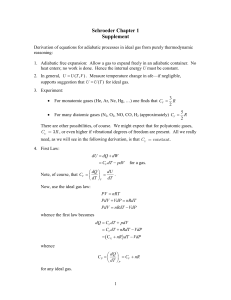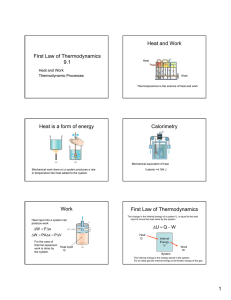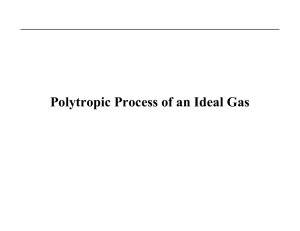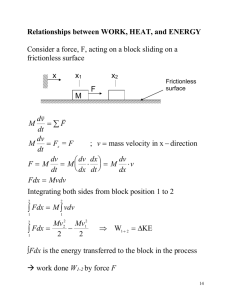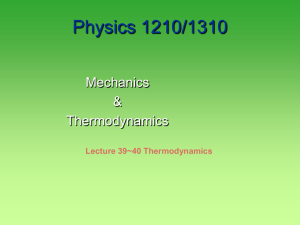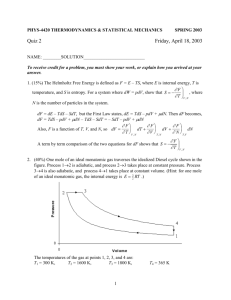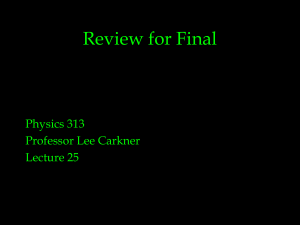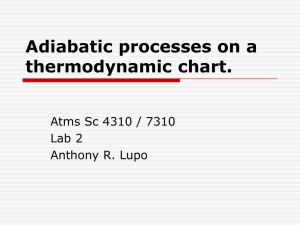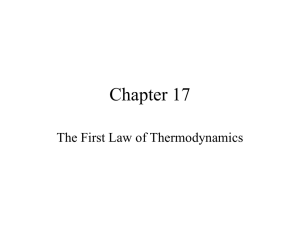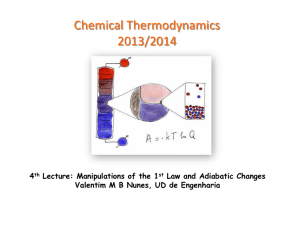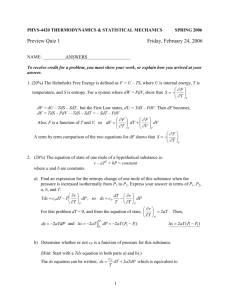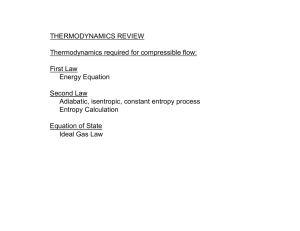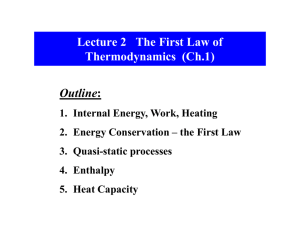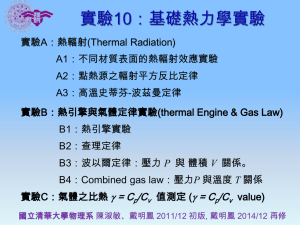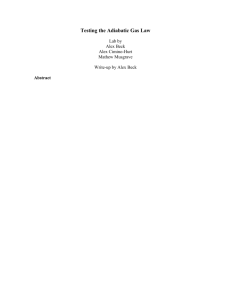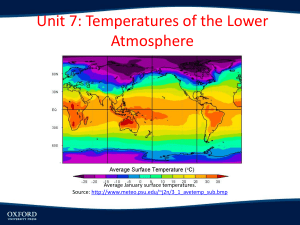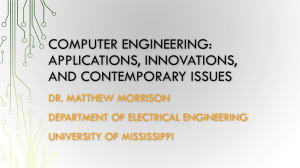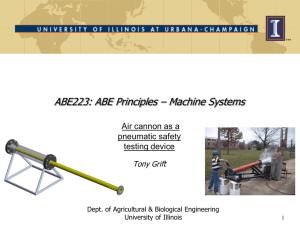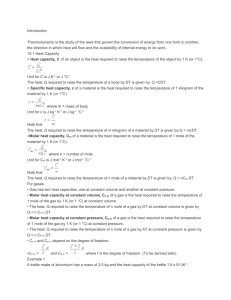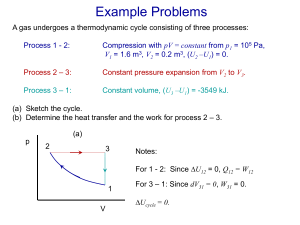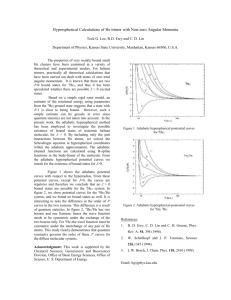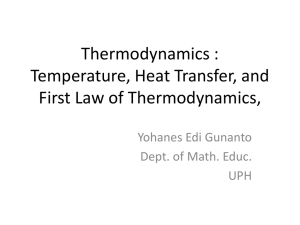Process calculation in ideal gas
advertisement
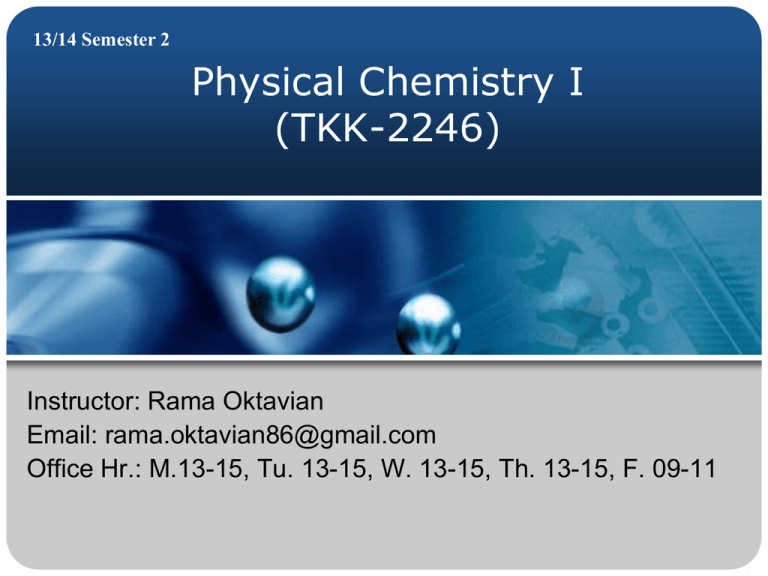
13/14 Semester 2 Physical Chemistry I (TKK-2246) Instructor: Rama Oktavian Email: rama.oktavian86@gmail.com Office Hr.: M.13-15, Tu. 13-15, W. 13-15, Th. 13-15, F. 09-11 Outlines 1. Change in energy 2. Change in state at constant volume 3. Change in state at constant pressure 4. Adiabatic change state (Process calculation in ideal gas) Change in energy Energy is an extensive state property of the system Energy per mole is an intensive state property of the system Energy is conserved in all transformations First law thermodynamic dU = dQ + dW dU of the system depends only on the initial and final states Q and W depends on path Change in energy First law thermodynamic dU = dQ + dW dU of the system depends only on the initial and final states. Define U = U(T,V) U U dU dT dV T V V T Substituting dU from the first law thermodynamic U U dQ dW dT dV T V V T Change in energy First law thermodynamic U U dQ dW dT dV T V V T dW pdV U U dQ pdV dT dV T V V T Change in energy First law thermodynamic U U dQ dW dT dV T V V T dW pdV U U dQ pdV dT dV T V V T Change in energy First law thermodynamic U U dQ pdV dT dV T V V T d ( nU ) dQ pd ( nV ) This is the general first-law equation for a mechanically reversible, closedsystem process Change in energy Example of energy change – state and path function Change in state at constant volume First law thermodynamic U U dQ pdV dT dV T V V T d ( nU ) dQ pd ( nV ) Change state at constant volume dV 0 U dQ dT T V Change in state at constant volume New properties – heat capacity U dQ dT T V U dT T V dQ Heat capacity at constant volume CV U T V Change in state at constant volume Heat calculation at constant volume CV U T V dU C V dT U2 dU U1 If Cv constant U2 dU U1 T2 CV dT T1 T2 C T1 V dT Change in state at constant volume Heat calculation at constant volume d ( nU ) dQ pd ( nV ) dQ dU Valid for constant volume process U2 Q dU U1 U2 Q U 2 U1 dU T2 U1 T2 Q C T1 V dT Heat calculation at constant volume process C T1 V dT Change in state at constant pressure In laboratory practice most changes in state are carried out under a constant atmospheric pressure Change in state at constant pressure Recall first law thermodynamics mathematical formulation d ( nU ) dQ pd ( nV ) Integrating this equation at constant pressure, we obtain Change in state at constant pressure Rearranging this equation Change in state at constant pressure Introducing new extensive state property of system Enthalpy Valid for constant-pressure process Change in state at constant pressure Heat calculation at constant pressure process constant pressure process Change in state at constant pressure Heat calculation at constant pressure process Heat capacity at constant pressure process If Cp is constant Valid for constant pressure process Implied property relation for ideal gas Relation between Cv and Cp CV U T V Adiabatic change Adiabatic – no heat flow the first law statement is dU dW dU pdV Adiabatic change Adiabatic change state in ideal gas C v dT pdV For ideal gas pV nRT Adiabatic change Integrating this equation from initial state (T1, V1) into final state (T2, V2), we have If Cv is independent to temperature (T) Adiabatic change For ideal gas we have relationship Adiabatic change PVT relationship for adiabatic change state in gas ideal Adiabatic change Adiabatic change PV-graph Learning check Check and Re-do example 7.3 from Castellan An ideal gas, Cv = 5/2 R, is expanded adiabatically against a constant pressure of 1 atm until it doubles in volume. If the initial temperature is 25 °C, and the initial pressure is 5 atm, calculate T2 ; then calculate Q, W, ΔU, and ΔH per mole of gas for the transformation. Assignment Open your textbook (Castellan) and do these following problem: Problem 7.1, 7.4, 7.10, 7.15, 7.17 The constant-pressure heat capacity of a sample of a perfect gas was found to vary with temperature according to the expression Cp /(J K−1) = 20.17 + 0.4001(T/K). Calculate q, w, ΔU, and ΔH when the temperature is raised from 0°C to 100°C (a) at constant pressure, (b) at constant volume. Process in ideal gas Isothermal Process (constant temperature) for closed system process Governing equation Process in ideal gas Isobaric Process (constant pressure) for closed system process U C V Q H dT Process in ideal gas Isochoric Process (constant volume) for closed system process Q U Process in ideal gas Example
